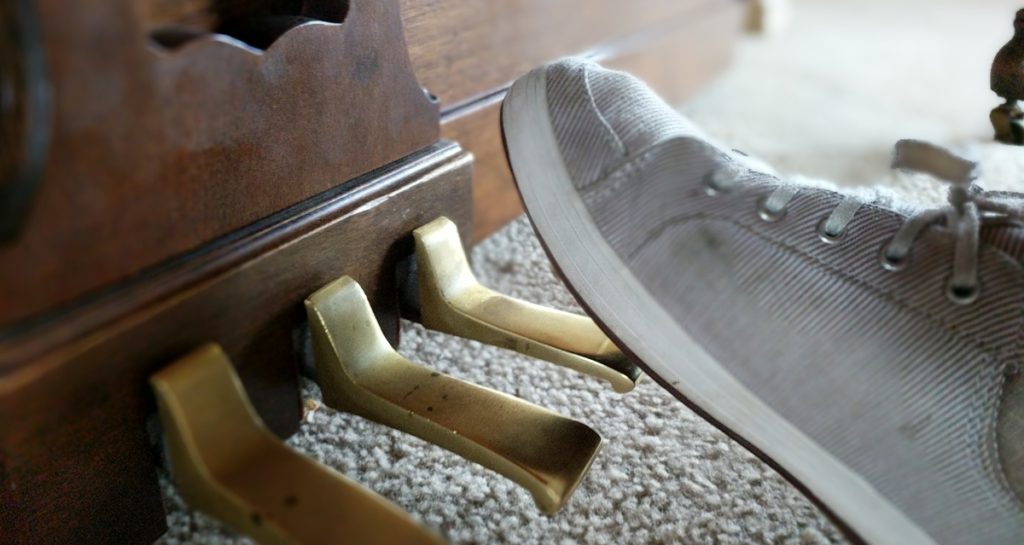
It is so fun to start playing the sustain pedal! Using the sustain pedal adds such a full sound and it is so fun to start playing around with the pedals and see the effects on your music. Too much of a good thing can be bad though.
So when do you let go of the sustain pedal? The sustain pedal should be held then let go according to the written music. Look for the music symbols shown in the music by a line underneath the music, or an asterisk, which is showing you to lift up the pedal. If there is no written direction in the music, then follow the general rule of thumb of letting go of the sustain pedal after every measure. Take care to only let go of the sustain pedal after you have played a note, so that the break in the sound will not be obvious.
Playing the sustain pedal takes a little bit of skill, but with some practice, it becomes second nature. Just don’t forget these guidelines.
When to let go of the sustain pedal
Letting go of the sustain pedal is an important skill to master. If you don’t let go of the sustain pedal at the right time, you will either end up with some really choppy sounding music, or you will have music that sounds really muddy and unclear. It really isn’t tricky to figure out and it becomes so second nature you don’t even have to think about it. It’s just like driving a car and knowing when to lift the pedal. You don’t even realize you are doing it anymore!
If there isn’t written notation within the music, then you will have to learn what sounds best when playing the sustain pedal. Before you begin playing the notes that you want sustained, press down the pedal. You can also press the pedal and the keys simultaneously. Play the music for about a measure, or possibly even as long as a musical phrase, or sentence. You can usually tell what is a musical phrase or sentence by looking for the slurs, or the arcs you find over the tops of a set of notes.
When you play for about the length of the measure (or the musical phrase – whichever sounds better) then lift up the pedal after you play the last note. If you want to continue playing the sustain pedal, then immediately press the pedal back down again. You want to lift the pedal and push back down on the pedal as seamlessly as possible. It takes just the split of a second to do this. To make sure you can do this as smooth as possible, make sure that your heel is pressed down at a comfortable distance from the pedal. Do not lift your heel, just the front of your foot. The heel acts as a pivot point for the foot as you press and lift up on the pedal.
If you are able to lift and press down quickly on the pedal after you have played a note on the keyboard and before you lift up on that note, then it can provide a sustained sound throughout the music. Continued lifting of the pedal will allow the music to keep that sustained sound without it becoming jumbled up or muddy by holding the pedal for too long.
Holding the pedal for too long can really make your music sound amateur. So make sure to lift the pedal at times that sound right. Listening to your music and what it sounds like is a key part of playing the piano well. Its a good practice to record yourself, because often we sound different than we think we do. Once you are able to record yourself, you can listen to it and critique the sounds. Play around with the pedal to see if you can make it sound any better. Ask others for their feedback as well as you seek to get it right.
You will want to develop good habits from the beginning so don’t just press forward without making sure that you have the right idea down. Once you do, you will be playing it without even realizing it! And it will sound fabulous.
Adjust the pedal to the song
As you play the sustain pedal and get more and more used to it, you will come to notice that some songs sound better with more pedal, and some songs deserve less pedal. One common mistake of beginners it to assume all music sounds better with a sustain pedal. This simply isn’t true! Only play the sustain pedal when it brings the enhancements you are looking for.
A sustain pedal is used to create a legato, or smooth sound. Sustain pedals are usually more appropriate during slower songs. When there are more complex songs with a lot of scales or run up and down the piano, a sustain pedal can become counter-productive as it blurs the sounds and takes away from the music. For a sustain pedal, often times less is more. So be aware of what kind of music you are playing and when and if you should play the sustain pedal at all.
The last thing you want to do, or get into the habit of doing, is to use the sustain pedal as a way to mask your music. It is easy to believe you are fooling your audience by just using the sustain pedal to mask your mistakes or to blur it together on purpose to hide your imperfections. Obviously, this will only harm you in the long wrong. A sustain pedal is certainly not a way to “cheat” your way through the music. The only one who will be fooled by this is the pianist as they think they sound better than they do.
A note for electric pianos: get the right sustain pedal
You can do all that is possible to make the pedal sound right, but if you don’t have a quality sustain pedal, then you may as well just resign yourself to the fact that it just isn’t going to sound quite right. It is well worth the extra few dollars to get yourself the right sustain pedal. Most electric pianos come with a pretty wimpy pedal. That pedal just won’t do. Do yourself a favor and get one that will not only last you much longer, it will provide you the sound quality you are looking for. You will have a much easier time with a better pedal.
Check out this high quality pedal here. It has lasted me through thick and thin and still held up really well. It also allows for me to press and lift it much more like an acoustic piano. It also has a quick response — something the cheaper pedals do not have.
When to hold the pedal down (and some awesome ideas to try with it)
The sustain pedal can be a fabulous tool and you can create some amazing enhancements to your music if used appropriately. Here are some things you may want to try when using the pedal.
- Use the sustain pedal during ritardandos (when the music slows down) or when you want to draw out a phrase in the music.
- Use the sustain pedal to make a statement. Adding some pedal to an accent can really bring it out and give it an extra punch.
- Use the sustain pedal to elongate a chord and cause it to “ring”. If done right, you can have that chord ring for a bit while you continue on with the song (with the pedal pressed halfway down).
- Try holding the pedal down at different levels. Try just slightly holding the pedal at times. Then try holding it down all the way. While other times, try holding it half way down. Holding the pedal down at different levels causes some differences in the sound and it can bring some interesting dynamics to a song as you play with it.
- Give the music variety by playing the music dramatically with the pedal, then cause a stark contrast when the pedal is released.
The most important thing is to listen!
if I haven’t said it enough, then let me say it again. Listen to yourself! Playing the piano is a skill that comes best when the ear is trained well. Record yourself, listen to yourself, over and over. Always keep an active ear as you play. Try different things and adjust as needed.
Related Questions:
What are the 3 piano pedals on an acoustic piano used for? The left pedal is called the soft pedal or the damper pedal and it is used to soften the notes of the piano to make it more muted. The middle pedal is called the sostenuto pedal and it allows you to be more selective about which notes you would like sustained. Some middle pedals have different functions than this though. The right pedal is the sustain pedal, which is used to sustain all the notes being played as long as the pedal is held down.
Do I need a sustain pedal for my keyboard? In the very beginning stages of your playing, the sustain pedal won’t be needed. But it won’t take you long before you are using the pedal more and more often. While you can hold off getting a sustain pedal for a little bit, you will definitely want to purchase a sustain pedal before long.
Tel loves her life as a piano player, a piano teacher, and a mom. Amid piano blogging, piano teaching, and piano playing, she loves a chance to fit in a good exercise class, volunteer at her kids’ school and at her church, and go on long dates with her husband. Full bio at About Tel.


